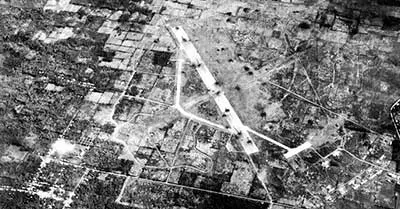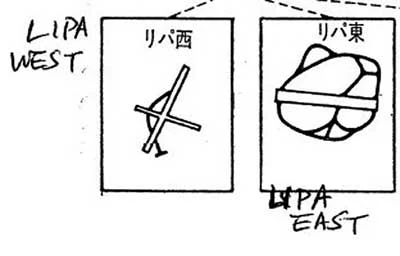Fernando Air Base: Its World War II Roots
Many historical accounts have already been written about Fernando Air Base. Thus, or so I thought to myself, if I wrote one at all, it would be one that would avoid the trap of being generic. After all, Fernando Air Base was where I was born and where I spent my formative years. To this day, I have nothing but fondness for this almost 300-hectare military facility.
The base was built over what used to be a sugarcane field by the United States Army before the outbreak of war in the Pacific in 1941. This is according to the World War II and Korean War oriented web site Pacific Wrecks.
On the 22nd of December 1941, 15 days after the Japanese attack on Pearl Harbour, the 27th Bombardment Group of the United States Army erstwhile based in Fort McKinley, presently known as Fort Bonifacio, was temporarily transferred to what was then known as Lipa Airfield but without aircraft. Three days later, the bombardment group packed up again and relocated to Cabcaben Airfield in Mariveles, Bataan. (The Official Chronology of the U.S. Army Airforce in World War II USAAF Chronology 1941-1942)
It had been sent to the Philippines because of escalating tensions, but the aircraft that were expected had been diverted to Australia to avoid destruction when war with Japan broke out. Although a United States Army Air Corps group, the soldiers were sent to Bataan to fight as infantrymen and later had to endure the infamous Bataan Death March. (Wikipedia)
Early the following year, Lipa Airfield was occupied by the 16th Division of the Japanese Army under a General Morioka. The airfield was repaired and expanded by the invaders during their occupation of the Philippines. (Pacific Wrecks)
Tony Feredo, a History enthusiast and owner of the ShellWings web site, sent me further information about the airfield that the Japanese had reconstructed. According to him, the airfield was known to the Japanese as the Lipa West Airfield.
It had two runways. One was made of concrete with a length of 4,140 feet and ran from northeast to southwest. The other was made of sod with a length of 4,593 feet running west-northwest to east-southeast.
What is not so well-known these days is that the Japanese, in fact, built a second airfield known at the time as Lipa East Airfield. According to Feredo, this airfield had a single runway but had taxiways; and a sketch of it appeared in the diary of a Col. Tonegi, Commanding Officer of the 33rd Air Sector, 149th Airfield Battalion of the Japanese Army.
Plotted on Google Earth, Lipa West Airfield was pretty much in what is present-day Fernando Air Base while Lipa East Airfield appears to have been in what is presently San Salvador, a village of Lipa City.
I have also seen references over the Internet documenting United States aircraft attacks on a Calingatan Airfield distinct from Lipa Airfield later in the war. I wonder, albeit I have found no evidence yet to support my conjecture, if Calingatan Airfield was, in fact, the same as Lipa East Airfield. Calingatan, after all, is a stone’s throw from San Salvador.
An American soldier named Paul Magee, who was taken prisoner by the Japanese, gave the insight that the construction of the airfields took up to the middle of 1943, “It was around the middle of ‘43… We were building an airfield there at Lipa, and the trains would come in bringing the large base rocks for the runway.” (A Prisoner of Japan: A POW’s own story, by Paul Magee as told to Paul H. Tarver)
I could find no other documents over the Internet about Lipa Airfield during the Japanese occupation; but its history came to life again in 1944 when the tides of war had changed and the Americans were starting to push the Japanese back.
In October 1944, the 75th Sentai, a unit of the Japanese Army equipped with twin-engine Kawasaki light bombers, was ordered to relocate to Lipa Airfield. The unit was withdrawing from Papua New Guinea, where the Japanese were being beaten by Allied Forces. It would later be given orders to pull back to Japan. (Arawasi)
Around this time, the American forces had grabbed a foothold in Leyte as Gen. Douglas MacArthur fulfilled his promise to return to the Philippines. The Japanese responded by sending 1,400 soldiers of the 2nd Parachute Brigade under the command of a Lt. Col. Tsunhiro Shirai. The soldiers flew out to Leyte from Lipa Airfield as well as Angeles Airfield, later to become Clark Air Base. (Hirohito's War: The Pacific War, 1941-1945 by Francis Pike)
When defeat started to stare the Japanese in the face, they became increasingly desperate and called upon their pilots to fly suicide missions called kamikaze. The pilots who volunteered to fly these missions crashed their planes into enemy warships. Lipa Airfield was one of the staging points from where these kamikaze missions took off. (Kamikaze Images)
Early in November of 1944, the Americans struck back by pounding both Lipa and Batangas Airfields with Hellcat, Helldiver and Avenger fighter aircraft launched from the aircraft carrier USS Hancock. (USS Hancock, CV/CVA-19 Fighting Hannah)
After the liberation of Manila in mid-1944, the Americans turned south to mop off remaining Japanese encampments. However, before the United States Army 18th Infantry Regiment, also known as the Rakkasans, could get to Lipa, it had to engage the Japanese in the Battle of Mt. Macolod, one of the bloodiest in the entire war. You and I know this mountain today as Mt. Maculot. (U.S.A. Airborne: 50th Anniversary, 1940-1990, Bart Hagerman, Ed.)
The operation was ordered by Gen. Oscar Griswold, commander of the army's XIV Corps; and its objective was the seizure of Route 19, considered the main road through what the army called the Lipa Corridor. A United States Army World War II map shows this to be likely present-day JP Laurel National Highway from Lipa City to Tanauan. (US Army in World War II, War in the Pacific, Triumph in the Philipines, by the Defense Department, Army, Center of Military History)
Japanese resistance ended on the first of May 1945 when the United States Army’s 11th Airborne Division captured Mt. Malepunyo, a mountain range dividing Lipa from San Antonio in Quezon. The army’s 127th Engineering Battalion then proceeded to build a new base around what used to be the Japanese’s Lipa West Airfield, lengthening the runway to accommodate C-47 transport aircraft. (11th Airborne Division)
The 11th Airborne was encamped at the newly built Lipa Airbase in May 1945 when news broke that Germany had surrendered and that the war in Europe had ended. The division, which played such a storied role in the war in the Pacific, would be called into action for the last time in Luzon just two months later when they flew from Lipa Airfield to reclaim Aparri Airfield in Cagayan.
The first aircraft, a C-46, took off early in the morning piloted by a Col. James Lackey. The aircraft circled above Lipa Airbase waiting for the other C-46, C-47 and glider aircraft to become airborne. When all the aircraft were airborne, they headed north in a V of V formation. (Blossoming Silk against the Rising Sun by Gene Eric Salecker)
This operation was the first time that gliders were being used in the Pacific, although these were used extensively to ferry soldiers in the European Theatre of War. (Out of the Blue: U.S. Army Airborne Operations in World War II by James A. Huston)
The next time the division would be called into action was when orders were given for it to fly out to Okinawa as the Americans put into action plans to finally put the Japanese to the sword. “From Lipa Airfield in Northern Luzon, planes flew northwest in a continuous stream toward Yontan and Kadena airports in Okinawa. By now, most of the division was bivouacked on the island. All units were advised that Japan was the next stop.” (The Fall of Japan by William Craig)
We all know, of course, the “Northern Luzon” in the previous paragraph is erroneous.
The airlift to Okinawa was in August, right smack in the middle of the monsoon season. Heavy rains hampered operations, weakening the steel matting at Lipa Airfield that a B-24 crashed while attempting to take off. (Out of the Blue: U.S. Army Airborne Operations in World War II by James A. Huston)
After the war, Lipa Airbase was turned over to the newly-independent Philippine government, initially to be known as the Lipa Army Air Base. (Hukbong Panghimpapawid ng Pilipinas) In 1948, President Manuel Roxas of the Philippine Republic issued a directive that formally renamed Lipa Airbase, built and expanded from the Japanese’s Lipa West Airfield, into the Basilio Fernando Air Base in honour of one of the pioneers of Philippine military aviation. (PAF web site)
Notes and references:
The author was born and spent his formative years inside Fernando Air Base, where his father was an officer and a pilot of the Philippine Air Force.


